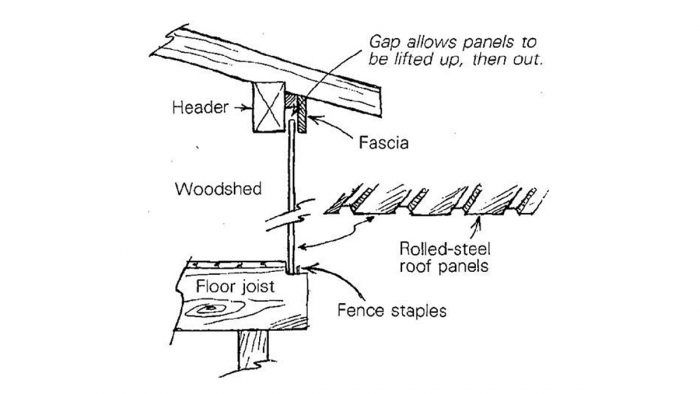Sheltered Woodshed
A removable panel makes loading firewood easy but protects the wood from rain and snow.

Our woodshed is near the driveway, where it is easy to load directly from our pickup. Unfortunately its loading bay faces into the weather, so I had to add a door to protect our firewood from rain and snow. As shown in the drawing, I used some leftover steel roofing panels that match our roof to make a removable wall.
At the top, the panels are held captive by the header and the fascia. At the bottom they are secured by the threshold on the inside and a row of fence staples on the outside. A space at the top of the panels gives me enough room to lift them out when I need to open the shed.
I’ve found that the 7-ft. high by 2-ft. wide roofing panels are sturdy enough to stand up to a strong wind. Lapped in the intended manner, they haven’t leaked, and the structure looks right at home next to our house.
—Ron Milner, Grass Valley, CA
Edited and illustrated by Charles Miller
From Fine Homebuilding #36






























View Comments
Sounds positively unsafe. Raw metal edges mixed with rain and snow. Potential trip to the emergency room.
Love the simplicity to this design--would work for anyone having a similar issue with the weather at their woodshed. Anyone who would worry about the "dangers" of this implementation probably has no woodshed, no tools anyway…they would be safe and sound inside their parlor room, sipping tea and eating crumpets while watching MSNBC. Thanks for the tip Ron!
Agree with William 100%. Besides, if you're handling firewood there's a strong liklihood that you'll be wearing gloves.
I use sheets of galvanized corrugated roofing in place of tarps, since today's tarps are useless when it comes to longevity. Yes, the edges can cut skin, but then those of use who get our hands dirty know that and proceed accordingly.
I use the same technique to weatherproof our chicken coop. In summer the huge south side windows are open, aside from predator proof fencing. In the fall it takes all of two minutes to snap in sheets of overlapping cloudy plastic panels (they probably have a name?). They fit loosely so plenty of ventilation equals happy chickens. I read the tip here a few years back, thank you!